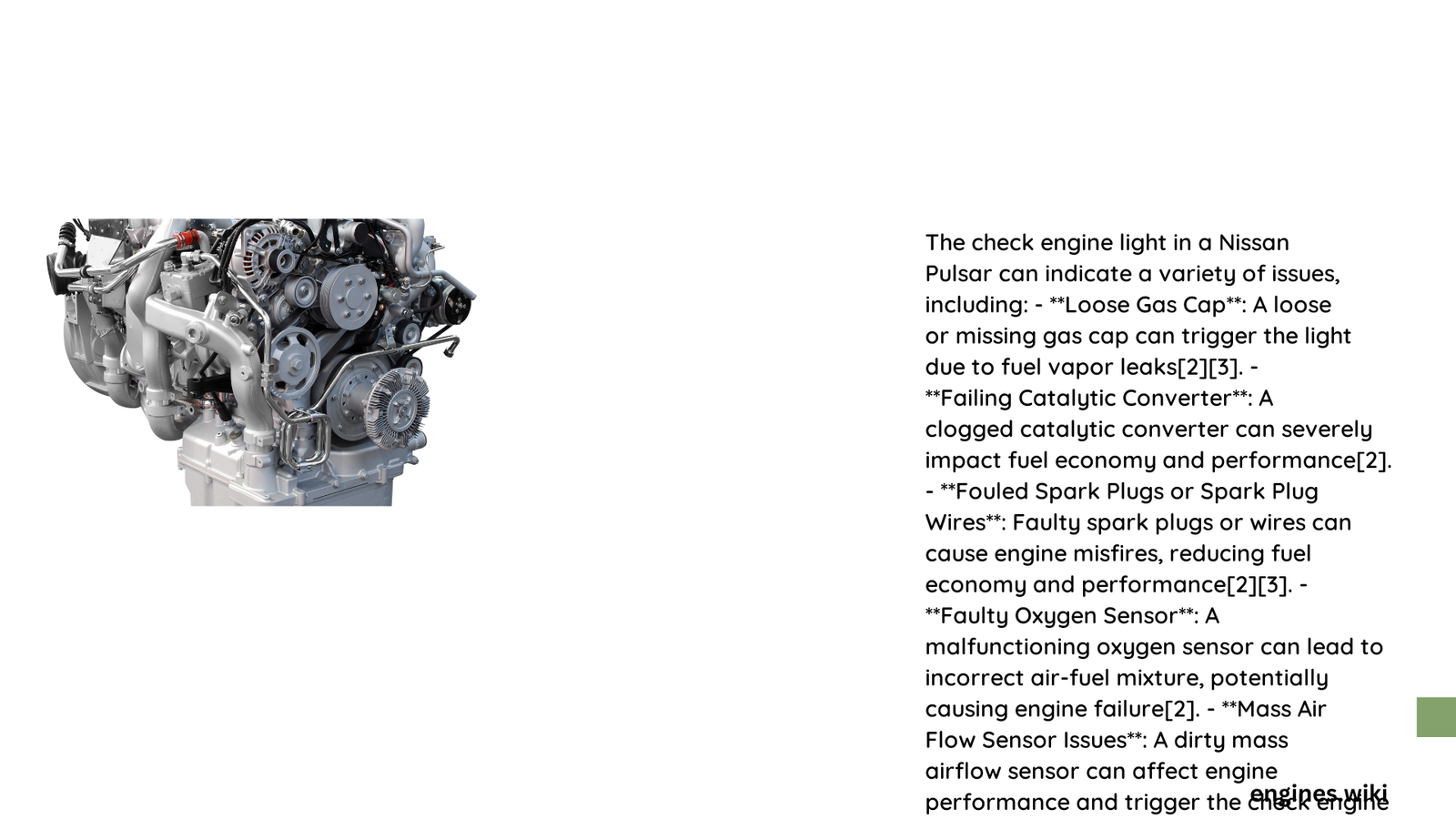The Nissan Pulsar’s check engine light represents a critical diagnostic indicator that signals potential mechanical or electronic system complications. When illuminated, this warning demands immediate attention, as it could indicate minor issues like a loose gas cap or more severe problems affecting engine performance, emissions systems, or critical vehicle components. Understanding the nuanced meanings behind this warning light can help Pulsar owners prevent costly repairs and maintain optimal vehicle functionality.
What Triggers the Check Engine Light in Nissan Pulsar?
Common Diagnostic Trouble Codes
| Code | Description | Potential Causes |
|---|---|---|
| P0300 | Random/Multiple Cylinder Misfire | Spark plug issues, ignition system failure |
| P0011 | Camshaft Position Timing Issue | Variable valve timing malfunction |
| P0010 | Variable Valve Timing Actuator Problem | Electrical or mechanical system failure |
Why Does the Check Engine Light Appear?
The check engine light can emerge from multiple scenarios:
- Sensor Malfunction
- Oxygen sensor degradation
- Mass airflow sensor contamination
-
Crankshaft position sensor failure
-
Mechanical Issues
- Worn spark plugs
- Damaged ignition coils
-
Exhaust system complications
-
Electrical System Problems
- Loose wiring connections
- ECU (Engine Control Unit) communication errors
- Faulty electrical components
How to Diagnose Nissan Pulsar Check Engine Light?

Diagnostic Steps
Professional Diagnostic Methods
- Connect OBD-II scanner
- Read and interpret trouble codes
- Perform comprehensive system analysis
- Verify sensor functionality
DIY Diagnostic Approach
- Check gas cap tightness
- Inspect visible wiring connections
- Listen for unusual engine sounds
- Monitor vehicle performance changes
What Are Potential Repair Strategies?
Recommended Repair Techniques
- Immediate Actions
- Use OBD-II scanner for precise code identification
- Verify sensor functionality
-
Check electrical connections
-
Systematic Repair Process
- Address immediate safety concerns
- Prioritize critical system repairs
- Replace faulty components
- Perform reset procedure
Can You Reset the Check Engine Light?
Reset Procedures
Method 1: OBD-II Scanner
- Connect scanner
- Select “clear codes” option
- Confirm reset
Method 2: Manual Reset
- Turn ignition to ON position
- Press accelerator pedal five times
- Wait seven seconds
- Hold accelerator for ten seconds
What Are Potential Cost Implications?
Repair Cost Estimates
| Severity | Estimated Cost Range | Typical Repairs |
|---|---|---|
| Minor | $50 – $200 | Sensor replacement, gas cap |
| Moderate | $200 – $500 | Spark plug, ignition system |
| Severe | $500 – $1500 | Major component replacement |
Expert Recommendations
Preventive Maintenance Tips
- Regular scheduled servicing
- Use high-quality engine components
- Monitor vehicle performance consistently
- Address warning signs promptly
Final Insights
Understanding your Nissan Pulsar’s check engine light requires systematic approach, technical knowledge, and proactive maintenance. While some issues might seem minor, prompt diagnosis can prevent extensive damage and costly repairs.
Key Takeaways
- Never ignore persistent check engine light
- Use professional diagnostic tools
- Maintain regular vehicle maintenance
- Address issues systematically
Reference:
– Nissan Official Diagnostics Manual
– OBD-II Diagnostic Codes Database
– Automotive Repair Guidelines
